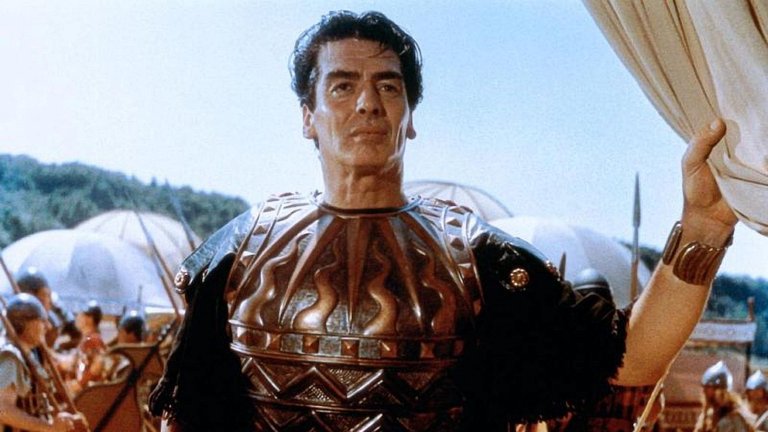Film Review: Hannibal (Annibale, 1959)

The Second Punic War stands as one of the most pivotal and dramatic military conflicts in the annals of the ancient world. Its significance is underscored by the audacity of its key figures, particularly Hannibal Barca, whose strategies and battles have been studied for centuries. Given its monumental nature, it was almost inevitable that this historical saga would be adapted for the silver screen during the era of grandiose sword-and-sandal epics. This adaptation came in 1959 with Hannibal, a film directed by Edgar G. Ulmer and Carlo Lodovico Bragaglia.
The plot begins in 218 BC, shortly after Rome has declared war on Carthage. Hannibal, portrayed by Victor Mature, is a Carthaginian general who has already achieved significant conquests in Spain and is driven by a desire for revenge against Rome for his nation’s earlier defeat in the First Punic War. His audacious strategy, intended to bring the war on Rome’s own soil, involves leading his army across the treacherous Alps during winter, a plan that results in substantial losses but also allows him to recruit disaffected Gauls and other factions opposed to Roman rule. Despite these reinforcements, Hannibal is still outnumbered and faces scepticism from Roman senators regarding his ability to contend with their well-trained legions. Only Fabius Maximus (played by Gabriele Ferzetti) advocates for a cautious approach, favouring guerrilla tactics and attrition warfare. Unfortunately, his counsel is ignored, leading to catastrophic Roman defeats at Trebia, Lake Trasimene, and ultimately Cannae. However, even after these victories, Hannibal struggles to deliver a final blow to Rome, complicated further by his growing affection for Sylvia (played by Rita Gam), Fabius’ niece, whom he initially captures as a hostage.
Produced by Warner Bros., Hannibal features a predominantly Italian cast and crew experienced in producing similar large-scale productions during the 1950s in Italy. The film was shot at Avala Film Studios in Belgrade, Yugoslavia, utilising a budget slightly lower than that of major Hollywood productions. Despite these constraints, Edgar G. Ulmer—known for his work on B-movies including the iconic film noir Detour—demonstrated an ability to create visually compelling scenes that belied the film's modest financial backing.
This visual ingenuity is particularly evident in the film's opening sequence depicting Hannibal’s army crossing the Alps. The combination of stunning mountain landscapes and carefully constructed sets (notably for the elephants) effectively conveys the harrowing challenges faced by Hannibal’s troops. The portrayal of deprivation and suffering among the soldiers adds a layer of realism that heightens the drama of this ambitious military manoeuvre.
Regrettably, following this impressive opening sequence—which lasts approximately twenty minutes—the film begins to, much like Hannibal’s army, go south. The screenplay co-written by Ulmer, Mortimer Braus, and Sandro Continenza shifts focus from Hannibal’s military exploits to an underdeveloped romantic subplot between him and Sylvia. While this love story holds potential—beginning with Hannibal's initial intent to use Sylvia as a pawn in psychological warfare—it fails to develop meaningfully throughout the film.
The romantic theme could have added depth; however, it is executed poorly. Victor Mature’s portrayal of Hannibal exudes charisma befitting a leader of men, yet there is a palpable lack of chemistry between him and Rita Gam's Sylvia. Despite her striking appearance reminiscent of a femme fatale archetype, Gam’s performance does not resonate with authenticity or emotional weight.
Gabriele Ferzetti delivers a commendable performance as Fabius Maximus, and, despite relatively youthful looks, embodies the wisdom and strategic foresight of a wise leader. However, his effectiveness is undermined by Mario Girotti (later known as Terence Hill), an actor who, despite looking only slightly younger than him, plays Fabius’ son Quintillius. Girotti's character develops romantic feelings for Sylvia, introducing an awkward incestuous undertone that apparently slipped by contemporary censors.
For fans of Terence Hill, there is an additional point of interest: Carlo Pedersoli (later Bud Spencer) also appears as Rotarius, a Gaul chief allied to Hannibal. Although Hill and Spencer do not share any scenes together in this film, eight years later their pairing in spaghetti western God Forgives… I Don’t would start one of the most iconic on-screen partnerships in history of 20th Century cinema.
Despite featuring hundreds of extras and grand battle scenes, Hannibal’s combat sequences leave much to be desired. Ulmer and Bragaglia take creative liberties with historical accuracy by introducing elephants as Hannibal's supposed "Wunderwaffe" against Roman forces. While visually striking at times—particularly with graphic violence that pushes late 1950s standards—the battles lack coherence and strategic depth. The depiction of Cannae—a battle that has for centuries been meticulously analysed by military historians—is rendered chaotic and confusing.
The film's conclusion is perhaps its most disappointing aspect; it resolves Sylvia's subplot through an unconvincing arrival of Hannibal’s estranged wife Danila (Mili Vitali) and their young son (Piero Tiberi). Heartbroken by this turn of events, Sylvia returns to Rome where she faces dire consequences for her perceived betrayal. Following this dark twist, the film neglects to address the aftermath of Hannibal’s campaign against Rome—an omission that feels glaring given its historical significance.
Ultimately, Hannibal emerges as a disappointment—a film better regarded as a curiosity than as a serious historical epic. Its potential is starkly illustrated by more coherent portrayals such as Hannibal: Rome’s Worst Nightmare, a 2006 BBC television docudrama featuring Alexander Siddig that offers a more comprehensive exploration of the Second Punic War.
RATING: 4/10 (+)
Blog in Croatian https://draxblog.com
Blog in English https://draxreview.wordpress.com/
InLeo blog https://inleo.io/@drax.leo
Hiveonboard: https://hiveonboard.com?ref=drax
Rising Star game: https://www.risingstargame.com?referrer=drax
1Inch: https://1inch.exchange/#/r/0x83823d8CCB74F828148258BB4457642124b1328e
BTC donations: 1EWxiMiP6iiG9rger3NuUSd6HByaxQWafG
ETH donations: 0xB305F144323b99e6f8b1d66f5D7DE78B498C32A7
BCH donations: qpvxw0jax79lhmvlgcldkzpqanf03r9cjv8y6gtmk9
Posted Using InLeo Alpha